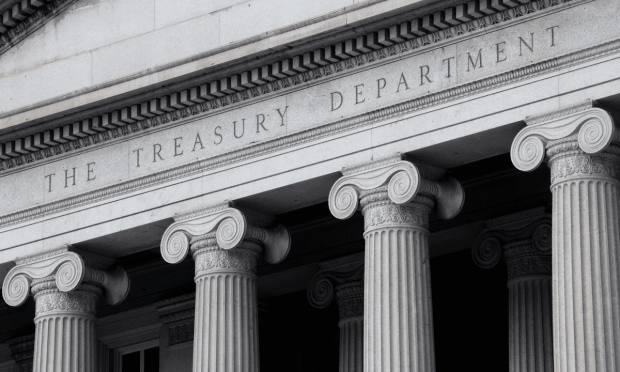Instant Payments, Stablecoins Sit Atop Treasury Dept’s Innovation Agenda

After six months of work, the U.S. Treasury Department has released a trio of reports on cryptocurrency policy, and instant payments are high on the agenda.
In the first of them, “The Future of Money and Payments,” the government looked at both the current state of payments and recent innovations, most notably real-time payments tools like the Federal Reserve’s forthcoming FedNow system and The Clearing House’s RTP network, as well as potential innovations that cryptocurrency stablecoins could bring.
It also discussed the current international movement toward creating central bank digital currencies (CBDCs), coming down firmly on a position that amounts to, “We’ll think about it.”
While the report started out by noting that the “current U.S. system of money and payments has substantial strengths [having] supported over a century of U.S. economic and financial leadership” and is “capable of processing an enormous volume of transactions in an efficient and reliable manner” while users “enjoy privacy protections,” it points to several shortcomings.
Most notably, these are legacy payment systems that “can be slow, difficult to adapt, and challenging for some consumers or businesses to access.” And, especially given a significant underserved population, there’s plenty of room to improve financial inclusion.
Instant Payments
Instant payments systems like FedNow and the RTP Network have several benefits, the report stated, notably preserving the current system while offering more efficient tools, as well as potential improvement to inclusion.
It offered several recommendations on how to make it more successful by speeding adoption.
First, it suggested expanding the “range of institutions that are eligible to participate [and] the number of institutions that choose to participate,” noting that only depository institutions insured by the Federal Deposit Insurance Corporation are currently eligible to participate in RTP, while FedNow will be accessible to all depository intuitions, along with foreign banks operating in the United States — although it wouldn’t handle cross-border payments.
However, expanding the range of eligible financial institutions (FIs), as some foreign jurisdictions have done, could increase speed, efficiency and inclusion.
Stablecoins
The second is a cryptocurrency innovation, dollar-pegged stablecoins, which “aspire to be a new type of money supported by a novel payments technology” but bring greater risks than existing or incoming instant payment systems, as well as potential impacts on those systems that the Treasury Department said are difficult to predict.
Aside from their growing use — or at least the predicted growing use — in mainstream payments outside of the crypto trading sphere, there are anti-money laundering (AML) and combating the finance of terrorism (CFT) concerns, particularly among global stablecoins.
Then there are “algorithmic” stablecoins that aren’t backed by stable assets like cash or Treasury notes that have lost their dollar peg, most notably the run that led to the $48 billion collapse of the Terra/LUNA stablecoin ecosystem in May.
“Poorly designed or inadequately regulated or supervised stablecoin arrangements — including both issuers and custodial wallets — may introduce or amplify risks to the financial system, consumers and investors, and illicit finance,” the report noted.
See also: Further Stablecoin Collapses Fuel Credibility Problem
There is widespread agreement in Congress that only stablecoins backed 100% by cash and highly liquid reserves should be allowed.
The report did not, however, include anything about stablecoins in the recommendations section.
Recommendations
On the instant payments front, the report didn’t suggest anything specific beyond saying that the results of real-time payments systems in other countries have been encouraging, and that the government should support their expansion and rollout.
Broadly, the Treasury Department wants a clear regulatory framework that would support innovation.
First, it called for a greater focus on financial inclusion of the unbanked and underbanked, on expanding consumer access to and use of instant payments, and on making the systems work across borders.
Secondly, the government should encourage interoperability of these systems, and possibly create “public-private partnerships to explore possibilities for low-tech instant payment system access.” It also suggested that government agencies support the use of instant payments systems in a broad range of areas.
Thirdly, the report stated the government’s policy should be to encourage “participation by nonbank payments companies,” although with strong regulatory and supervisory regime, consumer protection, and AML/CFT oversight.
One potential area of conflict with Congress is the report’s recommendation for federal oversight of these nonbank payments companies, saying “state oversight of nonbank payment providers varies significantly and is generally not designed to address run risk, payments risks or other operational risks in a consistent and comprehensive manner.”
It framed this as providing “a common floor for minimum financial resource requirements and other standards,” but nonetheless could run into the kind of backlash the department’s recommendation that only FDIC-insured institutions be allowed to issue stablecoins did.
Read also: A Primer on US Stablecoin Regulations
Finally, it called for greater focus on cross-border payments, although again, largely with generalities.
For all PYMNTS crypto coverage, subscribe to the daily Crypto Newsletter.